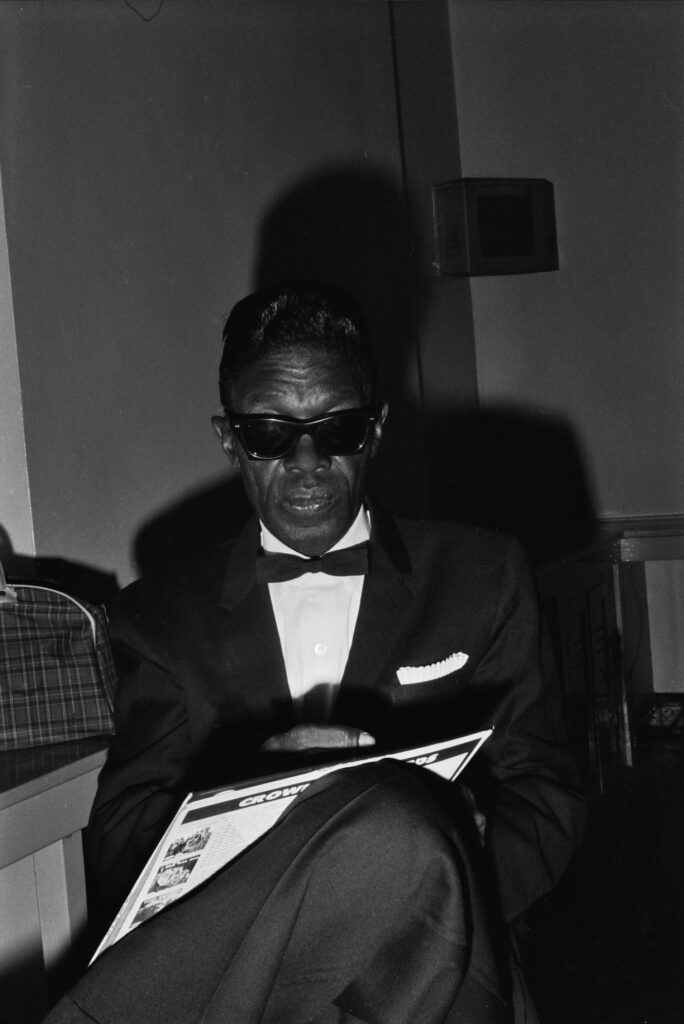Artist Spotlight: Lightnin’ Hopkins

Lightnin’ Hopkins
Early Life and Introduction to Music:
Born Sam John Hopkins on March 15, 1912, in Centerville, Texas, Lightnin’ Hopkins was destined to become one of the most influential blues guitarists and vocalists of his time. His early life was marred with challenges; having lost his father at a young age, he was introduced to the world of music by his elder brother, Joel, who taught him the basics of blues guitar.
Hopkins’ journey with the blues began when he met the legendary Blind Lemon Jefferson at a church function in Buffalo, Texas. Jefferson, who was a friend of his elder brother, left an indelible mark on the young Hopkins. The influences of Jefferson’s raw, emotive style, combined with the acoustic blues traditions of Texas, were foundational in shaping Hopkins’ musical direction.
Signature Style and Musical Characteristics:
Lightnin’ Hopkins was renowned for his distinct, deeply personal style. He often performed with just his guitar, voice, and occasionally a harmonica, creating an intimate sound that stood out even in the electrified era of the blues.
- Impromptu Songwriting: Hopkins was known for his ability to craft songs on the spot. He’d frequently compose lyrics reflecting immediate events or his surroundings, making his performances feel current and spontaneous.
- Guitar Technique: His guitar playing was both intricate and raw. He frequently utilized open tunings and employed a finger-picking technique that combined rhythmic bass patterns with melodic treble strings, giving the illusion of multiple guitars playing at once.
- Vocal Delivery: His voice, deep and resonant, conveyed a range of emotions from sorrow to joy, often mirroring the storytelling nature of his lyrics.
Career Highlights and Notable Recordings:
In 1946, after a chance meeting with Lola Anne Cullum of Aladdin Records, Hopkins’ recording career took off. Relocating to Los Angeles, he recorded his first hits, “Katie Mae Blues” and “Short Haired Woman”.
Throughout the 1950s and 1960s, Hopkins released a plethora of recordings. While it’s challenging to pinpoint every standout track in his extensive discography, albums like “Lightnin’ Hopkins” (1959), “Mojo Hand” (1960), and “Lightnin’ Strikes” (1962) are seminal works that showcase his immense talent.
Hopkins’ influence wasn’t limited to the blues genre. He collaborated with folk artists like Pete Seeger and Joan Baez during the American folk music revival, bridging the gap between blues and folk and introducing his sound to a broader audience.
Influence and Legacy:
Lightnin’ Hopkins’ influence is profound and multifaceted:
- Blues and Beyond: His impact on the blues genre is immeasurable. Artists like Jimi Hendrix, Stevie Ray Vaughan, and Townes Van Zandt have cited him as an influence. But it wasn’t just blues musicians; rock bands like The Grateful Dead and The Rolling Stones also drew inspiration from Hopkins.
- Cultural Impact: Hopkins became a figurehead in the 1960s folk revival, representing the authentic voice of the blues. His performances at folk festivals and collaborations with folk artists introduced many young listeners to the world of the blues.
- Texas Blues: While the Delta blues of Mississippi is often highlighted, Lightnin’ Hopkins put Texas firmly on the blues map. His style is often regarded as the epitome of Texas blues, characterized by its raw, unembellished sound and intricate fingerpicking.
Later Life and Death:
Despite facing health challenges in his later years, Hopkins continued performing and recording into the 1970s. His passion for music remained undiminished until his death from esophageal cancer on January 30, 1982.
Reflection:
In the annals of blues history, Lightnin’ Hopkins stands as a titan. His ability to weave stories through his songs, his unique guitar playing style, and his deep, emotive voice made him a favorite among blues aficionados and casual listeners alike. More than just a musician, Hopkins was a storyteller, chronicling the experiences of African Americans in the South, their joys, sorrows, challenges, and hopes. Through his songs, he painted vivid pictures of life, love, hardship, and celebration. Today, his legacy lives on, reminding us of the power of authentic, heartfelt music and its ability to transcend boundaries, touch souls, and inspire generations.


